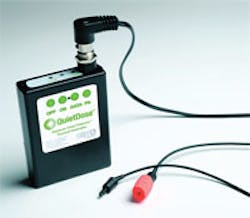Technology Proves, Improves Hearing Conservation
Like almost any forging operation, Dixie Industries in Chattanooga, TN, is a very loud place to work. Because operators stand in front of forging hammers to see and manipulate the product as it is being formed, it’s nearly impossible to protect them from the sounds resulting from excessive energy released by the closed-die and custom forging processes. The noise is a serious concern for safety managers at the Columbus McKinnon Corp. subsidiary.
Dixie Industries’ hearing conservation program required all workers to wear proper hearing protection throughout the facility, using dual protection (earplugs and earmuffs) in the forging area, where exposures average 110 dBA throughout the course of a workday (a 10-hour time weighted average, or TWA). The noise-reduction ratings — NRR — of earplugs were de-rated using the “subtract 7, divide by 2” method, with 5 dB added to that value to estimate attenuation of the dual protection.
Dixie Industries managers worked hard to find the right combination of approaches to provide proper hearing protection. In fact, over a decade, the company undertook 30 different projects to reduce overall noise, spending over $1 million to install baffles (sound-absorbing panels); redesign air-valve controls on hammers; install quieter auxiliary equipment; relocate non-forging workers away from extreme noise areas; and made a switch to less-noisy equipment.
But, when the forging equipment is generating forces estimated at 50,000 tons, and the combined mass of the top ram and dies often exceeds 6,000 lbs., precautions may not make a significant enough difference.
Once it received a citation from Tennessee’s Occupational Safety and Helth Administration, Dixie Industries was instructed to develop a detailed plan to minimize employee noise exposures. A hearing conservation professional recommended that production manager Ed Tougaw contact Drs. Kevin Michael and J. Alton Burks, who had introduced an in-ear dosimetry technology that measured and collected an individual’s daily noise exposure dose (protected and not) for another manufacturer.
This technology, known as QuietDose and available from Howard Leight, measures and records the worker’s actual noise dose over an entire shift. When worn as hearing protection, it measures sound pressure levels interior to the protector. During periods when it is not worn, it measures ambient noise levels, which is equal to the exposure outside of the ear.
Overall, QuietDose accounts for the ear’s actual noise exposure and provides real-time monitoring throughout the workday. The technology’s Exposure Smart Protector dosimeter alerts the worker when noise approaches or exceeds safe limits, and it collects data and provides safety managers with a comprehensive daily noise exposure report.
Tougaw felt that in-ear dosimetry could solve the problem of documenting noise with precise, personalized data. After gaining approval from management, he and the hearing conservation team at Dixie Industries presented their new plan to Tennessee OSHA (TOSHA) officials in two steps.
The first step was to show past, present, and planned engineering and administrative controls. “We referred to it as our ‘science fair’ presentation,” said Tougaw.
The team covered the walls of their conference room with photographs and samples of the previous 30 projects conducted over 11 years, which cost the company $1.8 million. “We also included proof of our administrative controls, including daily audits of our double hearing protection policy, and proof in the form of disciplinary action we were enforcing,” he detailed.
The second step was a proposal to use QuietDose to determine the actual exposure levels. “We were fortunate that representatives from TOSHA were aware of the product and open to the proposal,” added Tougaw. “They gave it their blessing and we kicked it off.” The team made the initial decision to use the technology as an instrument to collect actual exposure data, and not to use it as a replacement for its existing hearing conservation program.
Tougaw acquired a QuietDose in-ear starter kit, containing the Exposure Smart Protector dosimeters, microphone harnesses and eartips for each enrolled employee, software, and calibration equipment. Drs. Michael and Burks visited the plant and trained a team consisting of the environmental engineer, production supervisor, production manager, and two hammer operators to use the equipment. Six workers were enrolled full-time in the program, recording their daily dose over several months. Concurrent, ambient noise measurements also were recorded with a sound level meter.
Data from both in-ear and ambient dosimetry was collected and analyzed by the team. Workers using in-ear dosimetry experienced noise exposures under 90 dBA PEL; in fact, nearly all measurements were under 80 dBA. The workers exposed to the loudest noise achieved only 25% of their daily dose, proving that the protection plan in place was working.
For all of the efforts to mitigate noise through controls and estimates on hearing protection attenuation, inear dosimetry was able to determine that with proper protection, training, and motivation, workers can be protected adequately from extreme noise over an entire works shift.
“From our extensive field studies, we weren’t surprised to see that the workers were adequately protected, especially since they were wearing double protection,” said Dr. Michael. “In fact, nearly all industrial exposures can be reduced to a safe level with a properly fitted single hearing protector. We were thrilled to see data that indicated that Dixie Industries was providing adequate protection. This demonstrates that conventional de-ratings can be grossly inaccurate.”
The data collected through Dixie Industries’ audit was presented to TOSHA in April 2007, and the citation was abated two months later.
Since then, Dixie Industries has continued to use QuietDose to monitor the noise dose of its hammer operators on an annual basis. “The success of our in-ear dosimetry program sent a message that everyone could, and should, make a contribution to the overall safety environment at Dixie,” said Tougaw. He now considers QuietDose a ‘foundational element’ to the operation’s overall safety program, creating a valuebased safety culture.
Tougaw advises other manufacturers to take noise problems seriously, too. “Be persistent, don’t give up, and most of all, realize that agencies like TOSHA really are there to help, not hinder our development and success.”
